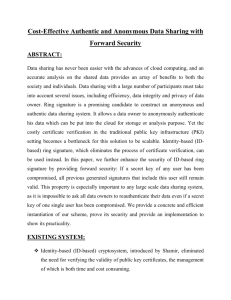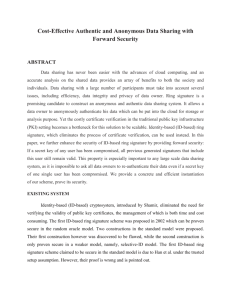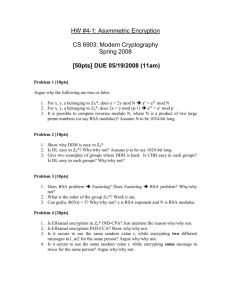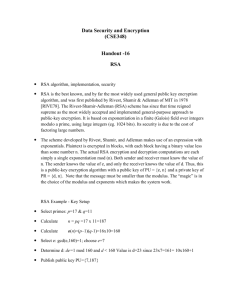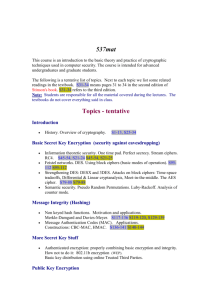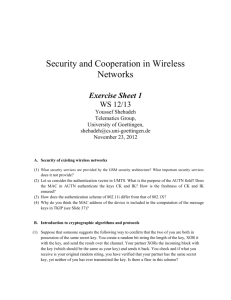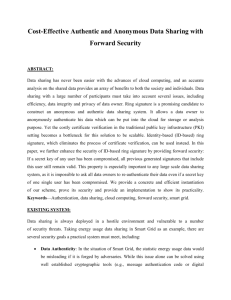doc - Jason Yi
advertisement
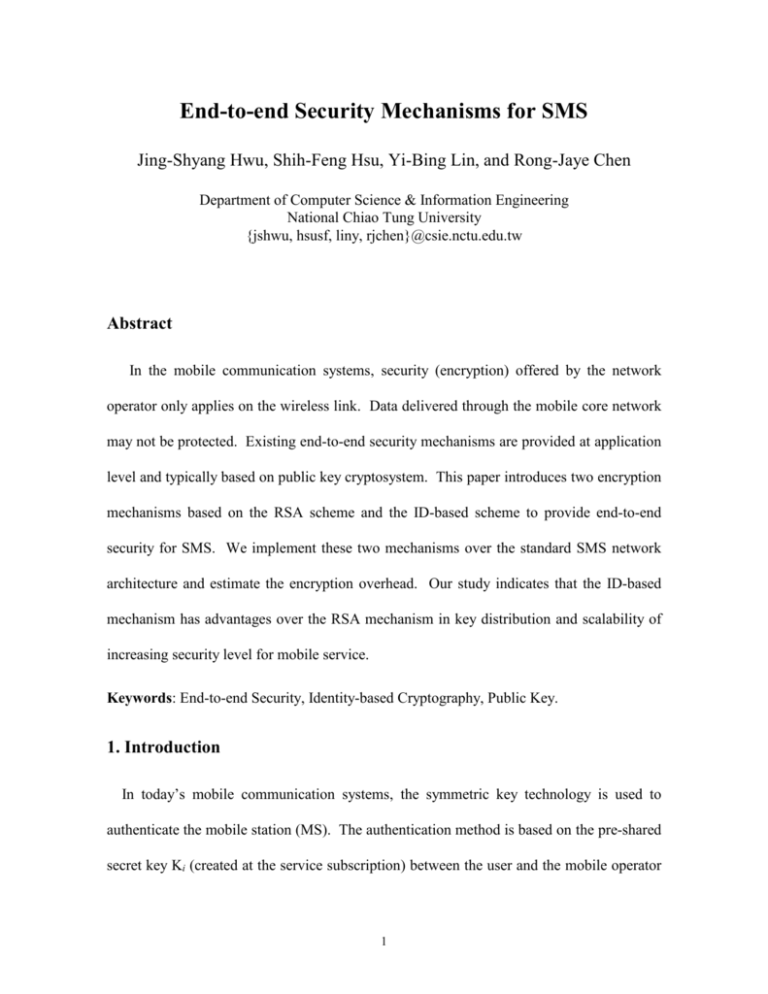
End-to-end Security Mechanisms for SMS
Jing-Shyang Hwu, Shih-Feng Hsu, Yi-Bing Lin, and Rong-Jaye Chen
Department of Computer Science & Information Engineering
National Chiao Tung University
{jshwu, hsusf, liny, rjchen}@csie.nctu.edu.tw
Abstract
In the mobile communication systems, security (encryption) offered by the network
operator only applies on the wireless link. Data delivered through the mobile core network
may not be protected. Existing end-to-end security mechanisms are provided at application
level and typically based on public key cryptosystem. This paper introduces two encryption
mechanisms based on the RSA scheme and the ID-based scheme to provide end-to-end
security for SMS. We implement these two mechanisms over the standard SMS network
architecture and estimate the encryption overhead. Our study indicates that the ID-based
mechanism has advantages over the RSA mechanism in key distribution and scalability of
increasing security level for mobile service.
Keywords: End-to-end Security, Identity-based Cryptography, Public Key.
1. Introduction
In today’s mobile communication systems, the symmetric key technology is used to
authenticate the mobile station (MS). The authentication method is based on the pre-shared
secret key Ki (created at the service subscription) between the user and the mobile operator
1
[6]. The symmetric session key Kc derived during the authentication phase (by using Ki) only
applies on the wireless link, i.e., from the MS to the base station. End-to-end security or
confidentiality and integrity over the whole path between two parties (e.g., an MS to another
MS) is not provided by mobile systems (such as GSM and UMTS) and therefore has to be
provided at application level. Asymmetric cryptography is typically used in mobile systems
to provide end-to-end security.
Asymmetric cryptography or public key cryptography (PKC) involves two distinct keys,
KU and KR. The public key, KU, can be widely distributed without compromising its
corresponding private key, KR. In some systems, KR remains only known to the user that
generated it, while in other systems, KR is given to a user by another trusted entity. To
generate the key pair, one first chooses a private key KR and applies some trapdoor one-way
function to KR to obtain a random and uncontrollable public key KU. The main concern in a
public key setting is the authenticity of the public key. If an attacker convinces a sender that
the receiver’s public key is some key of the attacker’s choice instead of the correct public key,
he/she can eavesdrop and decrypt messages intended for the receiver. This is the well known
man-in-the-middle attack [10]. This authentication problem is typically resolved by the use
of verifiable information called certificate, which is issued by a trusted third party and
consists of the user name and his/her public key.
In 1984, Shamir [9] introduced the concept of identity-based (ID-based) cryptography
where the public key of a user can be derived from public information that uniquely identifies
the user. For example, the public key of a user can be simply his/her email address or
telephone number, and hence implicitly known to all other users. A major advantage of
ID-based cryptosystem is that no certificate is needed to bind user names with their public
2
keys.
ID-based cryptosystem transparently provides security enhancement to the mobile
applications without requiring the users to memorize extra public keys. For example,
sending an ID-based encrypted short message is exactly the same as sending a normal short
message [3] if the mobile phone number of the short message recipient is used as the public
key. Therefore, the mobile user (the sender) does not need to memorize an extra public key
for the receiver. This feature is especially desirable for transaction-type mobile applications
such as bank or stock transactions [7].
In this paper, we implement two encryption systems for Short Message Service (SMS) and
estimate the encryption overheads compared with the original non-ciphered message
transmissions.
We first introduce the certificate-based and the ID-based public key
cryptosystems which provide authentic solutions for public key distribution. Then we
propose two applicable end-to-end encryption mechanisms for SMS based on the
certificate-based public key cryptosystem and the ID-based public key cryptosystem,
respectively. Finally, we also evaluate and compare the transmission overheads between
these two mechanisms.
2. Public Key Cryptography
Public key techniques utilize the asymmetric key pairs. In an asymmetric key pair, one key
is made publicly available, while the other is kept private. Because one of the keys is
available publicly, there is no need for a secure key exchange. However, it is required to
distribute the public key authentically. Because there is no need for pre-shared secrets prior
3
to a communication, public key techniques are ideal for supporting security between
previously unknown parties. Authentication is achieved by proving possession of the private
key. One mechanism for doing this is digital signature. A digital signature is generated with
the private key and verified using the corresponding public key. Since the public key of a key
pair is usually published in a directory, the overhead associated with distributing keys is
reduced significantly in comparison with secret key techniques.
A main concern in public key distribution is the authenticity of the public key. Fig. 1
illustrates how an adversary between a sender B and a receiver A can impersonate the
receiver A in the public key encryption scheme. The adversary achieves this by replacing A’s
public key KUA with a false public key KUA' which is then received by B (Fig. 1 (1) and (2)).
User B uses the false public key KUA' to encrypt the message M (Fig. 1 (3)). The adversary
obtains the secret message M (Fig. 1 (4)) and delivers the re-encrypted cipher to user A (Fig.
1 (5)). In this way, the secret message M is acquired by both user A (Fig. 1 (6)) and the
adversary. Similar impersonation settings exist between the signer and verifier in the
signature schemes. This is the well known man-in-the-middle attack. The following issue
arises from the need to prevent these kinds of attacks: how does B know (or authenticate)
which particular public key is A’s? To answer this question, authentication of public key
distribution is required. Authenticating public keys provides assurance to the entity that the
received public key corresponds to the sender’s identity.
4
Figure 1. The man-in-the-middle attack
2.1. Certificate-based Public Key Cryptosystem
A typical approach to guarantee the authentication of the public key holder relies on a
trusted agent named Certificate Authority (CA). The CA’s digital signature binds entity A’s
identity IDA to the corresponding public key KUA. The CA’s signature, when sent along with
the identity (e.g., name or telephone number) and public key, forms a digital certificate which
can be verified by any entity in possession of the CA’s public key.
This certificate provides a binding between the identity and the public key. Digital
certificates can contain extra information, such as cryptographic algorithms to be used in
conjunction with the public key in the certificate. The most widely adopted certificate format
is based on the X.509 standard [5]. A basic certificate issued by a CA for entity A is of the
form:
CertA = (IDA, KUA, SignKR_CA(IDA, KUA)),
where SignKR_CA(.) denotes the signing algorithm with the CA’s private key as the signing
key.
5
The certificate-based public-key distribution works as follows. User A first chooses a
public key cryptosystem, and generates his/her own key pair (KUA, KRA), where KUA
denotes the public key and KRA is the private key. To attain the authenticity of public-key
distribution, user A has to subscribe to the trusted Certificate Authority (CA; see Fig. 2 (1)),
and requests a certificate CertA for his/her public-key from CA (Fig. 2 (2)). The CA signs the
certificate with its private key. Then user A can send his/her certificate directly to another
user B (Fig. 2 (3)) or put it on the public key directory. Once user B is in possession of A’s
certificate, B verifies the certificate with the CA’s public key and has confidence that the
messages he/she encrypts with A’s public key will be secure from eavesdropping and that
messages signed with A’s private key are unforgeable.
Figure 2. The certificate-based public-key distribution
2.2. ID-based Public Key Cryptosystem
Shamir [9] proposed the identity-based (ID-based) public key approach to support public
key cryptography without the use of certification. In ID-based public key cryptosystem, user
A’s public key KUA is not delivered to user B, and therefore eliminates the attack presented in
Fig. 1. User B encrypts a message for user A or verifies a signature from user A using a
6
public key which is derived from user A’s identifier IDA (e.g., email address or telephone
number; see Fig. 3 (3)). The trusted agent has a new role in ID-based public key cryptosystem,
and is renamed as the Private Key Generator (PKG). The PKG issues the private key
corresponding to the public key (derived from the identifier IDA) to user A over a secure
channel (Fig. 3 (2)). This issuing action takes place after user A is authenticated by the PKG
(Fig. 3 (1)). To generate private keys, the PKG makes use of a master key which must be kept
in secret. The requirement to have an authentic CA’s public key for verifying certificates in
certificate-based cryptosystem is replaced by the requirement to have authentic PKG’s
system parameters in ID-based cryptosystem. Notice that both the PKG and the user A know
the private key KRA.
Figure 3. The ID-based public-key distribution
3. End-to-end Security for Short Message Service
This section first introduces the short message service (SMS) for GSM [6][7]. Then we
describe the RSA and the ID-based encryption mechanisms for SMS.
7
3.1. Short Message Service Architecture
The network architecture of short message service in GSM is illustrated in Fig. 4. In this
architecture, the short message is first delivered from the mobile station (MS) A to a short
message service center (SM-SC) through the base station system (BSS), the mobile switching
center (MSC), and then the interworking MSC (IWMSC). The SM-SC then forwards the
message to the GSM network through a specific GSM MSC called the short message service
gateway MSC (SMS GMSC). The SM-SC may connect to several GSM networks and to
several SMS GMSCs in a GSM network. Following the GSM roaming protocol, the SMS
GMSC locates the current MSC of the message receiver and forwards the message to that
MSC. The MSC then broadcasts the message through the BSS to the destination MS B. In
the next subsections, we will describe two encryption mechanisms for end-to-end secure
SMS based on certificate-based and ID-based cryptosystems.
Figure 4. GSM short message service network architecture
8
3.2. RSA Mechanism
The most
widely implemented approach to public key encryption is the
Rivest-Shamir-Adleman (RSA) scheme [8]. The RSA scheme is a block cipher in which the
original non-ciphered text and cipher text are integers between 0 and n-1 for some n. That is,
the block size kRSA is determined by the bit length of the integer n and regarded as the key size
of the RSA scheme. This scheme consists of the following three functions:
Key generation: A user first selects two prime numbers p and q, randomly chooses e
with gcd(e, (p-1)(q-1)) = 1, and calculates d e-1 mod (p-1)(q-1). Then the public key is
KU = (e, n) and the private key is KR = (d, n), where n = pq.
Encryption: For a given message represented as an integer M < n, the cipher text is
computed by C = M e mod n.
Decryption: For a given cipher text C, the original non-ciphered text is computed by
M = C d mod n.
A RSA mechanism for end-to-end secure SMS is introduced as follows. The end-to-end
security service provider (ESSP) plays a role as the CA in the certificate-based public key
cryptosystem. To access the end-to-end security service, a user first chooses his/her own key
pair (KU, KR) and subscribes to the ESSP for requesting a certificate of his/her public key
KU. The ESSP signs the certificate with its private key and publishes the certificate in the
public key directory for public access. When a mobile user A (the sender) wants to encrypt a
short message to user B, he/she first sends a public key request (Fig. 5 (1)) to the public key
directory in short message format. The public key directory retrieves user B’s certificate. If it
succeeds, user B’s certificate is sent to user A as the public key response (Fig. 5 (2)). Once
9
user A is in possession of B’s certificate, he/she verifies the certificate with the ESSP’s public
key and uses the user B’s public key to encrypt short message for B (Fig. 5 (3)). If the request
fails (due to unavailability of user B’s certificate), the ESSP will inform user B to subscribe to
end-to-end security service if he/she wants to securely communicate with user A.
Figure 5. The RSA procedure for sending an encrypted short message
3.3. ID-based Mechanism
In the above RSA approach, the sender needs to communicate with the public key
directory for requesting the public key. If the request fails (e.g., the directory server is down
or there is no certificate exist for the receiver), the sender can not encrypt short message for
the receiver. On the other hand, in an ID-based encryption scheme, the sender simply uses
the receiver’s ID (i.e., the telephone number) as his public key without any request and
verification. Thus, the sender does not need to access any public key directory before sending
an encrypted short message.
The first complete and efficient ID-based encryption scheme was proposed by Boneh and
Franklin [1] which uses a bilinear map called Weil pairing over elliptic curves. The bilinear
10
map transforms a pair of elements in group G1 and sends it to an element in group G2 in a way
that satisfies some properties. The most important property is the bilinearity that it should be
linear in each entry of the pair. Assume that P and Q are two elements (e.g., points on elliptic
curves) of an additive group G1. Let e(P, Q) be the element of a multiplicative group G2,
which is the pairing applied to P and Q. Then the pairing must have the following property:
e(rP, Q) = e(P, Q)r = e(P, rQ),
where r is an integer and rP denotes the element generated by r times of additions on P, e.g.,
2P=P+P, 3P=P+P+P and so on. Weil pairing on elliptic curves is selected as the bilinear
map. That is, the elliptic curve group (the set of point collection on elliptic curves) is used as
G1 and the multiplicative group of a finite field is used as G2.
The ID-based scheme consists of four algorithms: Setup, Extraction, Encryption, and
Decryption. Setup is run by the PKG to generate the master key and the system parameters.
This is done on input of a security parameter kID, which specifies the bit length of the group
order and is regarded as the key size of the ID-based scheme. The Extraction algorithm is
carried out by the PKG to generate a private key corresponding to the identity of a user. As
with regular public key cryptography, the Encryption algorithm takes a message and a public
key as inputs to produce a cipher text. Similarly, the Decryption algorithm is executed by the
owner of the corresponding private key to decrypt the cipher text. These four functions are
described as follows.
Setup: With the parameter kID, the algorithm works as follows:
1. Generate a random kID-bit prime p, two groups (G1; +); (G2; *) of order p, and the Weil
pairing e: G1 G1 G2. Choose an arbitrary generator P G1.
11
2. Pick a random number s Zp* and set Ppub = sP .
3. Choose cryptographic hash functions h1:{0, 1}*G1* and h2:G2 {0, 1}n for some n.
The public system parameters are {p, G1, G2, e, n, P, Ppub, h1, h2} and the master key s is
kept in secret by the PKG.
Extraction: For a given string ID{0, 1}* as the public key, the algorithm works as
follows:
1. Compute QID = h1(ID) G1.
2. Set the private key KR = sQID, where s is the master key held by PKG.
Encryption: To encrypt a message M under the public key KU = ID, the algorithm
works as follows:
1. Compute QID = h1(ID) G1.
2. Choose a random r Zp*.
3. Set the cipher text to be C = (U, V) = (rP, M h2(e(QID, sP)r))
Decryption: To decrypt a cipher C = (U, V) encrypted using the public key KU = ID, the
algorithm uses the private key KR = sQID to compute M = V h2(e(sQID, U)). This
decryption procedure yields the correct message due to the bilinearity of the Weil
pairing (i.e., e(sQID, U) = e(sQID, rP) = e(QID, sP)r).
Details of Weil pairing for ID-based cryptosystem can be found in [4], and will not be
elaborated further in this paper.
12
Based on an improved algorithm we proposed [4], an efficient ID-based end-to-end
encryption mechanism for mobile services is illustrated in Fig. 6. The PKG (Fig. 6 (1))
constructs the ID-based cryptosystem and uses, for example, the phone number as the ID (Fig.
6 (2)). Every mobile user involved in the ID-based cryptosystem is given a subscriber
identity module (SIM) card (Fig. 6 (3)) at the subscription time. The ID (phone number; e.g.,
0912345678 in Fig. 6) and its corresponding private key KR are loaded in the SIM card by the
end-to-end security service provider. Note that for standard GSM/UMTS service, SIM card
is always given to a mobile user at the subscription time and the proposed ID-based
encryption scheme can be pre-loaded into the SIM card without incurring any extra overhead.
The mobile station contains two security modules: ID-based encryption module (Fig. 6 (4))
and ID-based decryption module (Fig. 6 (5)). When a mobile user A (the sender; (Fig. 6 (6)))
wants to encrypt a short message to user B (the receiver), A uses B’s phone number
0912345678 (Fig. 6 (7)) as the public key and encrypts the message through the ID-based
encryption module. Once user B receives the cipher (the encrypted message), he/she uses the
private key KR (Fig. 6 (8)) stored in the SIM card to decrypt the cipher through the ID-based
decryption module and obtain the original non-ciphered message.
13
Figure 6. ID-based end-to-end encryption mechanism
To estimate the encryption overheads between the RSA and the ID-based mechanisms, we
implement these two encryption schemes and give the evaluation in the next section.
4. Performance Comparison
This section compares the transmission (encryption, decryption, and message delivery [3])
delay of ciphered short messages based on the RSA and the ID-based approaches. The
experimental environment is illustrated in Fig. 7. Both the sender and the receiver are
notebooks (Fig. 7 (1) and (3)) configured with a Pentium-III 500 MHz CPU, 256MB main
memory, and 20GB disk space, and are running on the Windows XP Professional operating
system. To deliver short messages, every notebook is plugged in a NOKIA Card Phone
14
version 2.0 and the short message is sent via the ChungHwa GSM network (Fig. 7 (2)) from
the sender to the receiver.
Figure 7. Encrypted short message experimental environment
We first note that to support the same security level, the key length for the ID-based and
the RSA approaches are different. The ID-based cryptosystem using Weil pairing is over
elliptic curves, thus its security level depends on the key length of Elliptic Curve
Cryptosystem (ECC). As listed in Table 1 [2], a 108-bit ECC key provides the same security
level as a 512-bit RSA key, a 160-bit ECC key provides the security level equivalent to a
1024-bit RSA key, and a 224-bit ECC key is equivalent to a 2048-bit RSA key. For a fair
comparison, we measure the transmission delays of ID-based system and RSA system over
the same security level, and the results are shown in Fig. 8.
Table 1 Key length for equivalent security levels (in bits)
ECC (ID-based)
RSA
108
512
160
1024
224
2048
15
This figure plots transmission delays of the RSA and ID-based approaches for the same
non-ciphered length (in bytes), where the ◆ curves represent the RSA transmission delays,
the ▓ curves represent the ID-based transmission delays, and the ▲ curves represent the
non-ciphered message delays.
Based on the RSA encryption algorithm described in Section 3.2, for a non-ciphered
message of length i, the RSA ciphered message length is
i
LRSA i k RSA
k RSA
where k RSA is the key length of RSA approach. For k RSA 512 ,
i 512
.
512 i 1024
512
LRSA i
1024
Therefore, in Fig. 8 (a), we observe a step curve for the RSA ciphered message transmission.
For k RSA 1024 and k RSA 2048 , if i 1024 , LRSA i is 1024 and 2048 respectively.
Therefore, in Fig. 8 (b) and (c), we observe horizontal lines for the RSA ciphered message
transmission.
Based on step 3 of ID-based encryption algorithm described in Section 3.3, the ID-based
ciphered message length is
LID i i
k ID
,
4
where k ID is the key length of ID-based approach. For a fixed k ID , LID i increases as i
increases. Therefore, in Fig. 8 (a), (b), and (c), we observe linear lines for ID-based ciphered
message transmission.
16
(a) 512 bits RSA key and 120 bits ID-based key cipher
(b) 1024 bits RSA key and 160 bits ID-based key cipher
(c) 2048 bits RSA key and 224 bits ID-based key cipher
Figure 8. Transmission delays of short message service
17
Based on the above transmission delay analysis, Fig. 8 (a) shows that the ID-based
approach outperforms the RSA approach when the non-ciphered message length is less than
30 bytes or is between 65 and 90 bytes. Fig. 8 (b) shows that the ID-based approach
outperforms the RSA approach when the non-ciphered message length is less than 79 bytes.
Fig. 8 (c) shows that the ID-based approach outperforms the RSA approach up to 140-byte
message limit of short message service. These figures indicate that as the security level
increases, it is more likely that the ID-based approach outperforms the RSA approach for the
SMS applications.
5. Conclusion
In this paper, two applicable end-to-end security mechanisms for SMS based on the RSA
scheme and the ID-based scheme are introduced and implemented. The ID-based scheme
provides a great simplification of key distribution. That is, all public keys can be derived
from the identities of the users. Therefore obtaining someone’s public key, for encryption or
verification, becomes a simple and transparent procedure. This is in contrast to the RSA
scheme, where one has to look up the corresponding certificate and verify the CA’s signature.
Another advantage of the ID-based scheme is the linear scalability of increasing security level.
When the security level increases, the key size of the RSA scheme increases faster than that
of the ID-based scheme and may not be practical for the SMS applications. Our study
concludes that the ID-based scheme offers a convenient end-to-end security mechanism for
mobile service such as SMS.
18
Reference
[1] D. Boneh and M. Franklin, “Identity-based Encryption from the Weil Pairing”, Advances
in Cryptology-CRYPTO’01, pp. 213–239.
[2] D. Hankerson, A. Menezes, and S. Vanstone, Guide to Elliptic Curves Cryptography,
Springer-Verlag, 2003.
[3] H.-N. Hung, Y.-B. Lin, M.-K. Lu, and N.-F. Peng, “A Statistic Approach for Deriving the
Short Message Transmission Delay Distributions”, IEEE Trans. on Wireless
Communications, vol. 3, No. 6, 2004.
[4] J.-S. Hwu, R.-J. Chen, and Y.-B. Lin, “An Efficient Identity-based Cryptosystem for
End-to-end Mobile Security”, Accepted and to appear in IEEE Transactions on Wireless
Communications.
[5] ITU-T Recommendation X.509, “Information technology - open systems interconnection
- the directory: Public-key and attribute certificate frameworks”, 2000.
[6] Y.-B. Lin and I. Chlamtac, Wireless and Mobile Network Architectures, John Wiley and
Sons, 2001.
[7] Y.-B. Lin and A.-C. Pang, Wireless and Mobile All-IP Networks, John Wiley and Sons,
2005.
[8] R. Revest, A. Shamir, and L. Aldeman, “A Method for Obtaining Digital Signature and
Public Key Cryptosystems”, Communication of the ACM, February 1978
[9] A. Shamir, “Identity-based Cryptosystems and Signature Schemes”, Advances in
Cryptology–CRYPTO’84, pp. 47-53.
[10] W. Stallings, Cryptography and Network Security, Prentice Hall, 1999.
19


